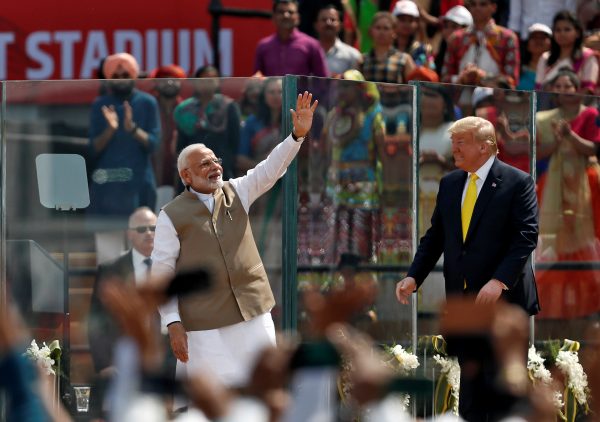The reorientation of India’s great-power relations is driven by two factors. One is the rise of China and Delhi’s growing power imbalance with Beijing. The other is Prime Minister Narendra Modi’s success in overcoming the entrenched anti-US sentiment in the Indian political and bureaucratic establishment.
The rise of China has become the single most important challenge facing India. Although India has a long record of befriending China, it has found Beijing largely unresponsive to Indian concerns. And as the gap in comprehensive national power widens in favour of Beijing, the traditional perception in Delhi of a broad parity with China has become unsustainable.
It is being replaced by the recognition that China is bound to expand its influence in India’s near and extended neighbourhood at Delhi’s expense. Meanwhile, the wider the gap, the less the incentive for China to settle the dispute over the long and contested frontier between the two nations in Tibet and Xinjiang.
China has not been responsive to India’s demands for more balanced bilateral trade (the trade deficit with China was running at around US$50 billion in 2019). More broadly, Delhi is coming to terms with the fact that it can no longer rely on Russia to balance China as it did from the 1960s to the 1990s. Delhi now sees Moscow drifting into a tighter embrace with Beijing.
That has made a closer security partnership with the United States a central theme of India’s foreign and security policies in the past few years. Along with growing volumes of bilateral trade (US$160 billion in 2019) and increasing purchases of US defence equipment (at a cumulative figure of $20 billion over the last two decades), Delhi has opened up to greater interoperability between the armed forces of the two nations, intensive counter-terror collaboration and political cooperation in the region and beyond.
That a significant expansion of India–US security cooperation took place under Narendra Modi remains an interesting political puzzle.
The Bharatiya Janata Party (BJP) was by no means enthusiastic about building a strong relationship with the United States. The BJP aligned with the Communists in opposing the civil nuclear initiative with the United States and sought to bring down the Manmohan Singh government during 2005–08. If Manmohan Singh was hobbled by opposition to a US partnership from the Communists and much of the Congress party itself, Modi had to cope with the deeply held wariness about the United States among Hindutva ideologues.
Substantive opposition to engagement with the United States came from the bureaucratic establishment. Large sections of the Ministry of External Affairs, the armed forces, the Defence and Home Affairs ministries and the science bureaucracy were sceptical of collaboration with the United States and had argued against any major change of policy that would strengthen ties with Washington. Multiple levels of opposition meant even the simplest elements of cooperation with the United States could not be advanced during the United Progressive Alliance (UPA) years (2004–14).
It is quite evident now that Modi came into power in 2014 with a determination to change this situation. From inviting a US president (Barack Obama) as the honoured guest at India’s annual Republic Day celebrations to flipping India’s position on climate change to work with the United States, Modi took steps that were previously inconceivable.
It was one thing to move forward with the United States but entirely another to publicly flaunt the bonhomie with Washington. In two large rallies — one in Houston with the Indian American community during September 2019 and one in a massive public reception for President Donald Trump in Ahmedabad in his home state, Gujarat, in February 2020 — Modi celebrated the special relationship and proclaimed the United States to be India’s most important partner.
Modi is acutely aware of the pitfalls of relying too much on the United States for India’s security. He is conscious of the current turbulence in US domestic politics and the prospect for quick shifts in US external orientation. Therefore, Modi is eager to retain the traditional security partnership with Moscow and carefully manage the difficult and increasingly asymmetric relationship with Beijing.
As the China challenge remains relentless, Delhi has no option but to compete with Beijing without locking itself into a costly confrontation. Modi is also aware that Washington and Beijing will always be tempted to arrive at some mutual accommodation that might not always be in the interests of China’s neighbours. As he copes with China’s rise and hedges against US unpredictability, the Indian Prime Minister is also eager to develop stronger ties with other middle powers like France, Japan, Vietnam, Indonesia and Australia.
Under Modi, Delhi has learned to discard its many traditional inhibitions in its dealings with Washington and instead to seize opportunities to strengthen India’s own position among the great powers.
C Raja Mohan is Director of the Institute of South Asian Studies at The National University of Singapore.
A longer version of this article appears in the most recent edition of East Asia Forum Quarterly, ‘Middle Power Game’, Vol. 12 No. 1.


Excellent analysis by C. Raja Mohan. “India is going the other way — moving into an ever-closer partnership with the United States and making a more intensive effort to balance China in the Indo-Pacific”. Here is my take on this via an article quoted below.
I am given to understand that various Business groups in California are reading this article of mine on India. Five Important Deals Boosting India-U.S. Bilateral Cooperation by RAMESH KUMAR NANJUNDAIYA/Special to India-West May 17, 2020 – India West Newspaper, California.